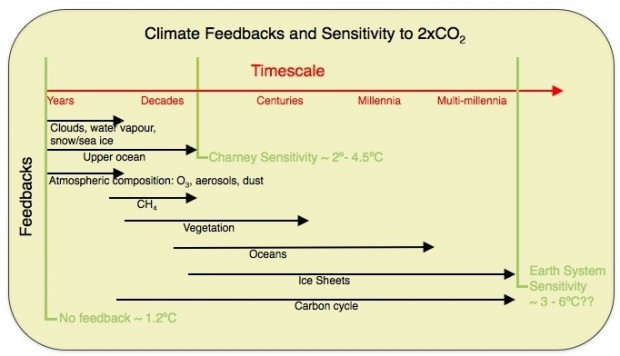Climate Sensitivity in the Anthropocene
Climate sensitivity in its most basic form is defined as the equilibrium change in global surface temperature that occurs in response to a climate forcing, or externally imposed perturbation of the planetary energy balance.
Dr. Kevin Trenberth explains general climate sensitivity on Earth.
Study: Climate sensitivity in the Anthropocene
![Climate sensitivity, sea level and atmospheric carbon dioxide. Hansen et al. 2013[1] (a) CO2 amount required to yield a global temperature, if fast-feedback climate sensitivity is 0.75°C per W m−2 and non-CO2 GHGs contribute 25% of the GHG forcing. (b) Same as in (a), but with temporal resolution 0.5 Myr and for three choices of fast-feedback sensitivity; the CO2 peak exceeds 5000 ppm in the case of 0.5°C sensitivity. The horizontal line is the Early–Mid-Holocene 260 ppm CO2 level.](http://climatestate.com/wp-content/uploads/2013/09/Fast_Feedback_Climate_Sensitivity-300x259.gif)
M. Previdi, B. G. Liepert, D. Peteet, J. Hansen, D. J. Beerling, A. J. Broccoli, S. Frolking, J. N. Galloway, M. Heimann, C. Le Quere, S. Levitus and V. Ramaswamy | Source
Climate sensitivity in its most basic form is defined as the equilibrium change in global surface temperature that occurs in response to a climate forcing, or externally imposed perturbation of the planetary energy balance. Within this general definition, several specific forms of climate sensitivity exist that differ in terms of the types of climate feedbacks they include. Based on evidence from Earth’s history, we suggest here that the relevant form of climate sensitivity in the Anthropocene (e.g. from which to base future greenhouse gas (GHG) stabilization targets) is the Earth system sensitivity including fast feedbacks from changes in water vapour, natural aerosols, clouds and sea ice, slower surface albedo feedbacks from changes in continental ice sheets and vegetation, and climate–GHG feedbacks from changes in natural (land and ocean) carbon sinks. Traditionally, only fast feedbacks have been considered (with the other feedbacks either ignored or treated as forcing), which has led to estimates of the climate sensitivity for doubled CO2 concentrations of about 3◦ C.
The 2×CO2 Earth system sensitivity is higher than this, being ∼4–6◦ C if the ice sheet/vegetation albedo feedback is included in addition to the fast feedbacks, and higher still if climate–GHG feedbacks are also included. The inclusion of climate–GHG feedbacks due to changes in the natural carbon sinks has the advantage of more directly linking anthropogenic GHG emissions with the ensuing global temperature increase, thus providing a truer indication of the climate sensitivity to human perturbations. The Earth system climate sensitivity is difficult to quantify due to the lack of palaeo-analogues for the present-day anthropogenic forcing, and the fact that ice sheet and climate–GHG feedbacks have yet to become globally significant in the Anthropocene. Furthermore, current models are unable to adequately simulate the physics of ice sheet decay and certain aspects of the natural carbon and nitrogen cycles. Obtaining quantitative estimates of the Earth system sensitivity is therefore a high priority for future work.
PALAEOSENS “Making sense of palaeoclimate sensitivity” 2012
Many palaeoclimate studies have quantified pre-anthropogenic climate change to calculate climate sensitivity (equilibrium temperature change in response to radiative forcing change), but a lack of consistent methodologies produces awide range of estimates and hinders comparability of results. Here we present a stricter approach, to improve intercomparison of palaeoclimate sensitivity estimates in a manner compatible with equilibrium projections for futureclimate change. Over the past 65 million years, this reveals a climate sensitivity (in K W21 m2) of 0.3–1.9 or 0.6–1.3 at 95% or68% probability, respectively. The latter implies a warming of 2.2–4.8 K per doubling of atmospheric CO2, which agreeswith IPCC estimates. Source Abstract | PDF


Gavin Schmidt noted: People often mean different things when they talk about sensitivity. For instance, the sensitivity only including the fast feedbacks (e.g. ignoring land ice and vegetation), or the sensitivity of a particular class of climate model (e.g. the ‘Charney sensitivity’), or the sensitivity of the whole system except the carbon cycle (the Earth System Sensitivity), or the transient sensitivity tied to a specific date or period of time (i.e. the Transient Climate Response (TCR) to 1% increasing CO2 after 70 years). As you might expect, these are all different and care needs to be taken to define terms before comparing things.
Related The cost of living in the Anthropocene
